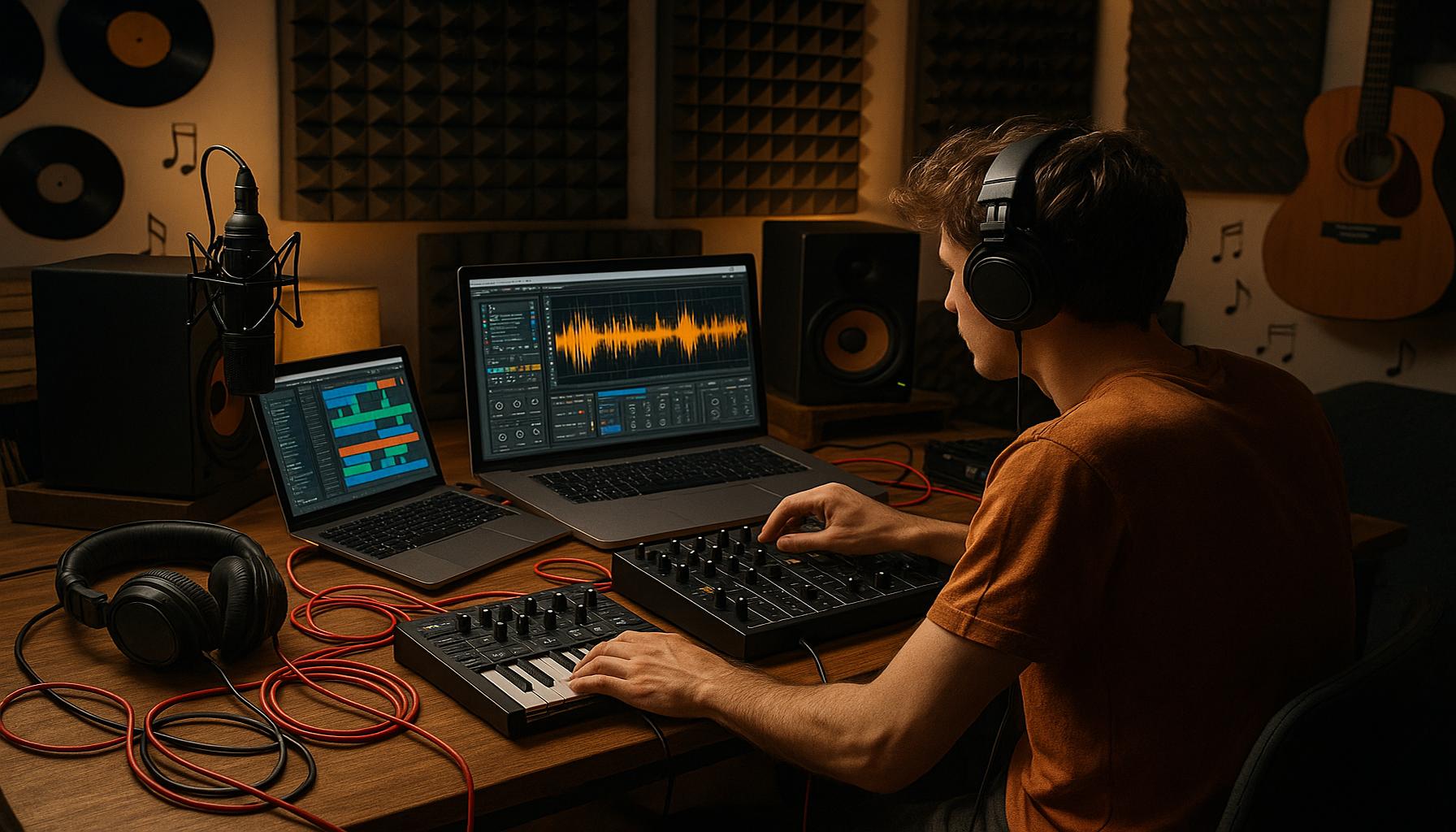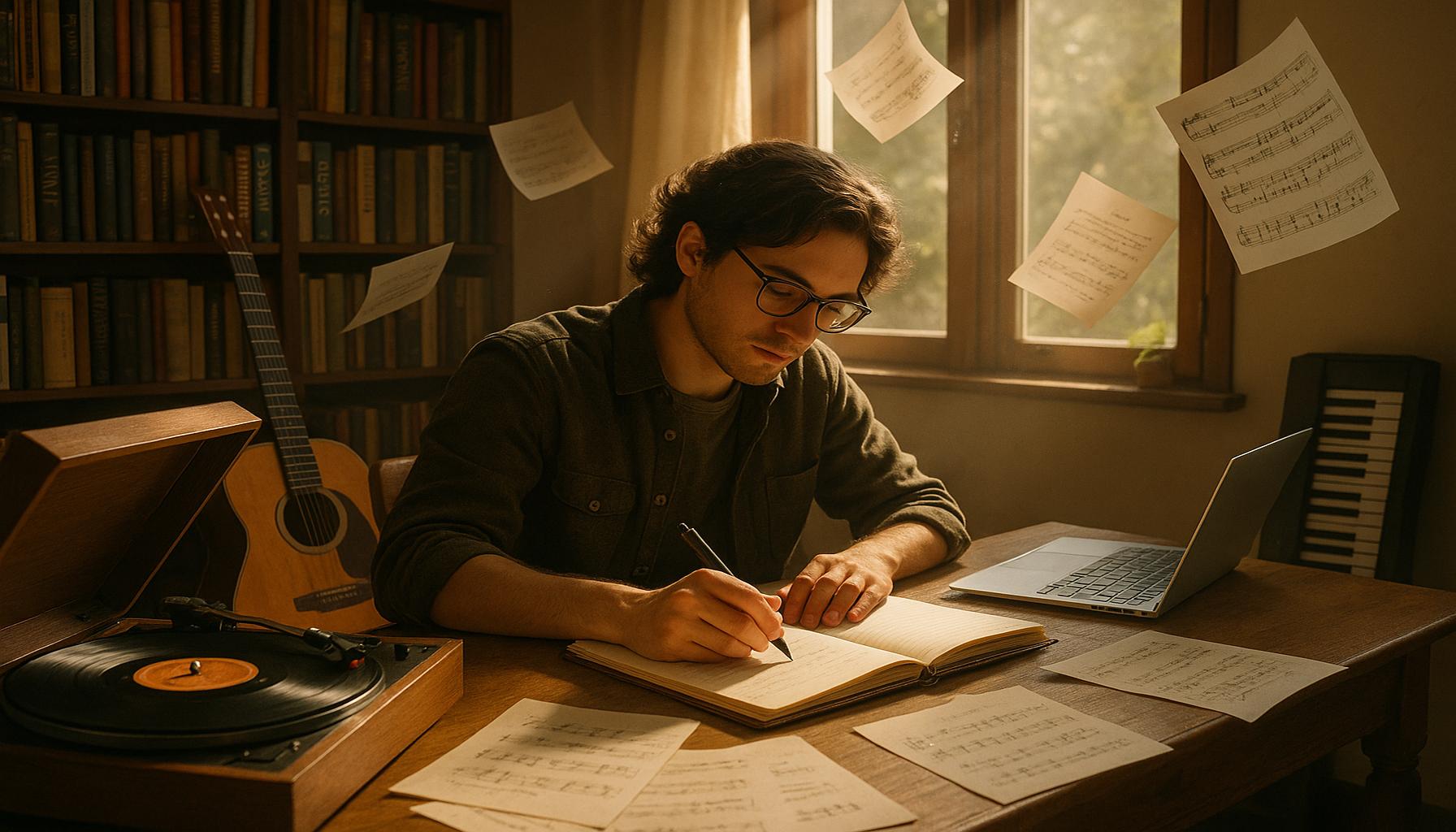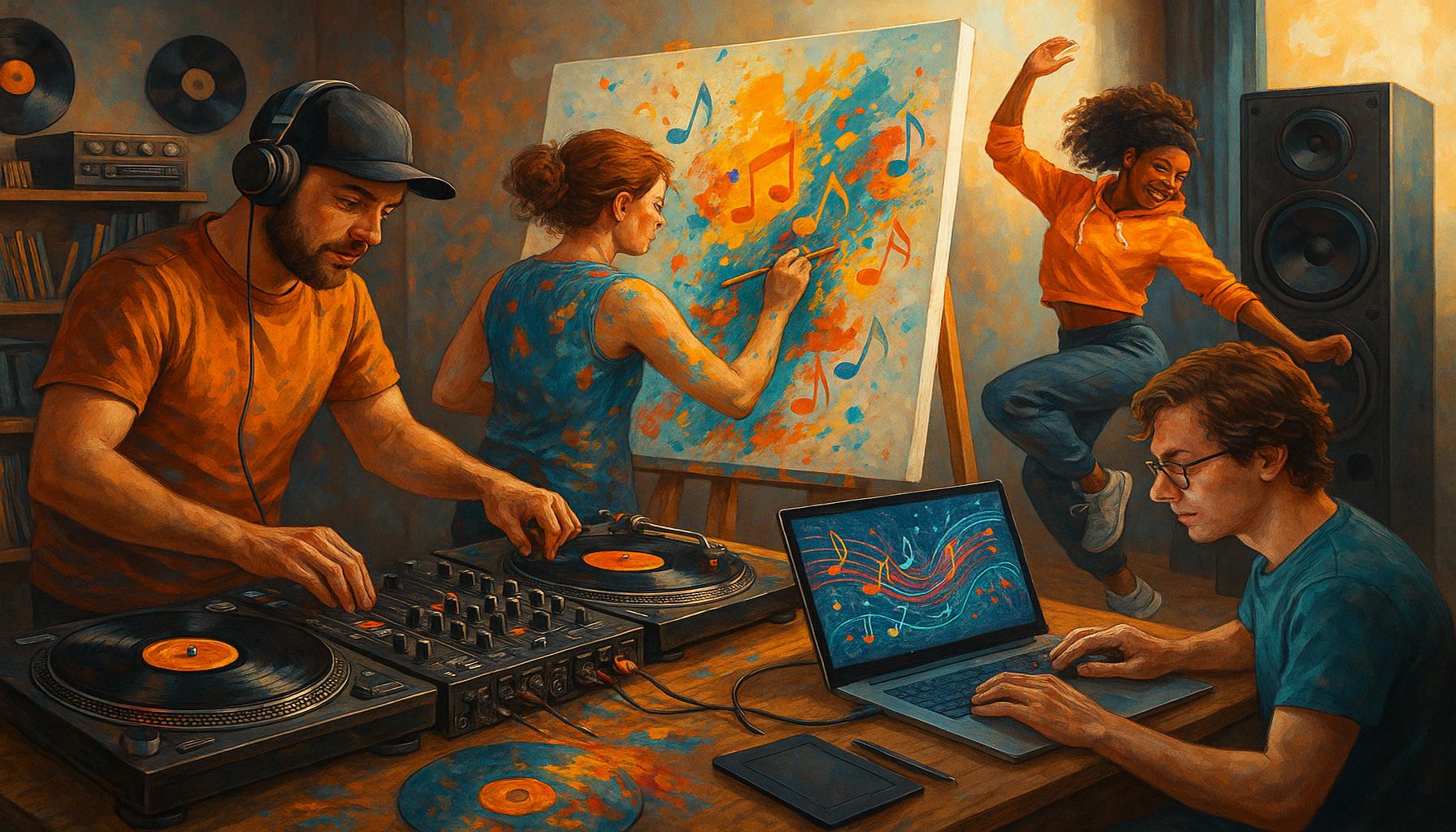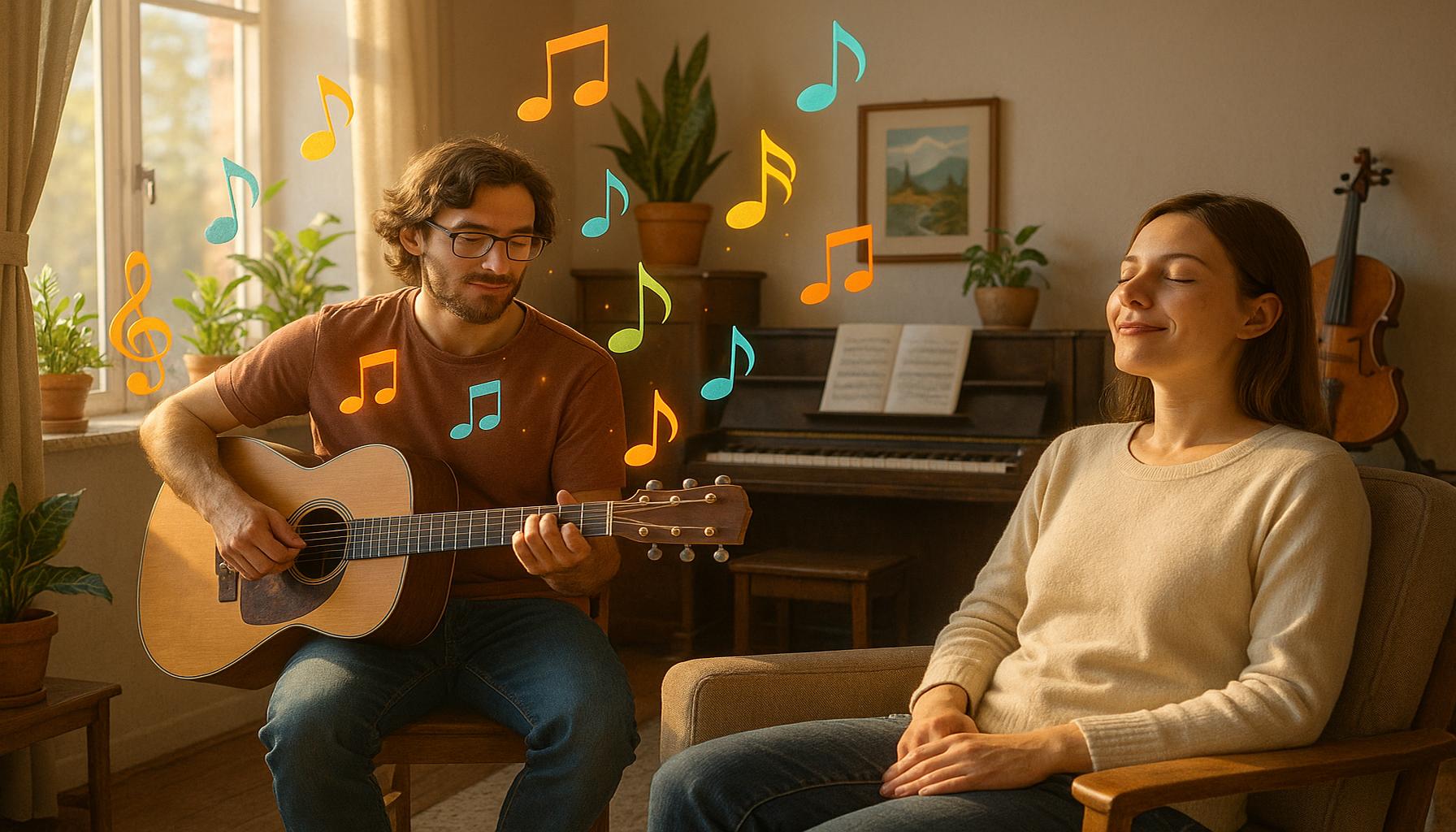The Impact of Digital Technology on DIY Music Production for Amateur Musicians

Transforming Music Creation
In recent years, the landscape of music production has undergone a transformative revolution, driven largely by the rapid development of digital technology. Gone are the days when aspiring musicians were constrained by the limitations of expensive studio equipment and extensive technical know-how. Now, with just a computer and a passion for music, anyone can embark on a journey of creativity and self-expression.
Affordable Software has played a pivotal role in democratizing music production. Digital Audio Workstations (DAWs) like GarageBand and FL Studio have made it possible for users to create music right from their living rooms. GarageBand, for instance, offers a user-friendly interface with built-in loops and instruments that cater to beginners, while FL Studio provides more advanced features that seasoned producers can appreciate. This accessibility allows musicians to produce high-quality tracks without needing a significant upfront investment.
The availability of quality plugins is another key advancement in this revolution. Today, an incredible variety of virtual instruments and effects can be seamlessly integrated into DAWs. Musicians can find plugins that emulate everything from classic synthesizers to intricate orchestral sounds, often available for free or at a low cost. For example, popular plugins like Serum or Kontakt provide professional sounds comparable to those found in high-end studios. This empowers artists to experiment with diverse genres and create unique sonic landscapes, further expanding their musical horizons.
Online collaboration has also reshaped the way music is made. With tools such as Splice and BandLab, musicians from different corners of the globe can connect, share ideas, and finalize tracks without ever meeting in person. This not only fosters a sense of community but also allows artists to blend various cultural influences into their work. For example, a producer in New York can collaborate with a singer-songwriter in London to create a transatlantic hit, showcasing how geography is no longer a barrier to musical creativity.
The implications of these advancements are profound. Amateur musicians can now:
- Create high-quality recordings from home: With the right software and a decent microphone, anyone can produce professional-grade tracks. Artists like Billie Eilish have exemplified this trend by creating hit songs in their bedrooms, which have topped charts worldwide.
- Share their music with a global audience: Platforms like SoundCloud and Bandcamp allow artists to distribute their work easily, often leading to unexpected fame. Many independent musicians have gained substantial followings on these platforms, highlighting the potential for success outside traditional record label systems.
- Engage with communities for collaboration and feedback: Online forums, social media groups, and music production tutorials provide vital support and insights. Artists can receive constructive criticism and mentorship from a diverse group of musicians, enhancing their skills and inspiring new ideas.
This newfound accessibility not only fosters personal expression among musicians but also sparks innovation across various music genres. By breaking down the barriers traditionally associated with music production, digital technology encourages diverse voices to emerge, leading to an ever-evolving music scene that reflects a multitude of influences and styles. As this trend continues, understanding the true impact of these digital tools will inspire further exploration into the future of DIY music production.
DIVE DEEPER: Click here to discover the art of musical expression
Empowering Creativity Through Accessibility
The surge in digital technology has not only made music production more accessible but has also empowered amateur musicians to explore their creativity without the fear of financial constraints. With a wide array of tools and resources now available at their fingertips, budding artists can not only produce music but also fine-tune their skills in ways that were once limited to those with access to professional studios.
One of the most significant breakthroughs in this realm is the rise of affordable recording equipment. In recent years, high-quality microphones, audio interfaces, and MIDI controllers have become increasingly budget-friendly. For example, brands like Audio-Technica and Focusrite offer gear that is not only cost-effective but also reliable, making it easier for amateur musicians to record vocals and instruments with clarity. This spike in affordability means that musicians who previously relied on DIY recordings with little more than a smartphone can now achieve studio-like sound quality from the comfort of their own homes.
Moreover, the growth of online tutorials and educational platforms has revolutionized how musicians learn. Websites like YouTube, Skillshare, and even dedicated music production blogs provide an abundance of resources for budding producers. From detailed guides on using specific software to lessons in music theory or mixing techniques, artists now have access to a wealth of knowledge that was previously unattainable for many. This self-directed learning pathway encourages musicians to take ownership of their craft and develop their unique sound.
The global pandemic also intensified this trend, as many artists turned to home studios to continue creating music while traditional performance venues were closed. This shift led to a surge in innovative projects, where artists began experimenting with sound and exploring new genres. The unique circumstances prompted many musicians to embrace technology as a means to adapt and thrive, demonstrating the potential for digital technology to foster resilience and innovation.
The proliferation of streaming services has further solidified the relevance of DIY music production. Platforms such as Spotify, Apple Music, and Tidal provide amateur musicians with unprecedented access to distribute their music to a global audience. Musicians can release singles, EPs, or full albums without needing the backing of a major label or extensive marketing budgets. This self-distribution model not only allows artists to retain greater control over their work but also increases their chances of gaining traction in an ever-crowded market.
The impact of these technological advancements can be categorized into several key areas that define the contemporary DIY music production landscape:
- Enhanced Quality: High-quality audio equipment and software tools contribute to superior production value.
- Learning Resources: A plethora of online platforms provide education on music production techniques.
- Distribution Opportunities: Streaming services enable easy access to a worldwide audience without the need for traditional industry support.
- Resilience and Adaptability: Artists can pivot and create new works even during significant disruptions.
As amateur musicians embrace these tools, we witness an explosion of creativity that reshapes the music industry. The blend of technology and artistry serves not only to redefine what it means to be a musician but also ensures that diverse voices are heard in the ever-evolving soundscape of the modern music scene. The future of DIY music production looks promising, with exciting opportunities on the horizon for those willing to harness the power of digital technology.
The Evolution of Tools for the Modern Music Maker
As the landscape of music production continues to evolve, so too do the tools available to amateur musicians. Digital technology has revolutionized the way music is created, enabling musicians to produce high-quality sound from the comfort of their own homes. In this section, we’ll explore the various digital tools and platforms available to budding artists, and how these innovations have shaped the DIY music production scene.Digital Audio Workstations (DAWs) have become the cornerstone of modern music production, providing a comprehensive platform for recording, editing, and mixing audio. Programs like Ableton Live, FL Studio, and GarageBand empower users to create intricate compositions with relative ease. These DAWs often come with a plethora of built-in instruments and effects, which not only reduce the need for costly equipment but also encourage creativity by allowing musicians to experiment with different sounds.Moreover, the rise of plug-ins amplifies production capabilities. With thousands available, musicians can access an array of virtual instruments and effects tailored to their specific needs. For instance, if an artist is looking to blend genres, they can easily incorporate synths, drum machines, and even orchestral sounds into a single track, something that would have been nearly impossible just a couple of decades ago.In addition to software, the accessibility of affordable hardware—such as MIDI controllers, audio interfaces, and microphones—has made it feasible for anyone with a passion for music to dive into production. These tools are designed for seamless integration with DAWs, streamlining the recording process and fostering greater authenticity in each artist’s work.The impact of social media and streaming services cannot be overlooked either. Platforms like SoundCloud, Bandcamp, and YouTube offer amateur musicians instant access to global audiences. These services empower artists to share their original compositions, gain feedback, and even monetize their work without the need for a traditional record label.As digital technology fosters a democratization of music production, amateur musicians are finding their voices—and their music—reaching audiences faster and further than ever before. The convergence of these innovations is not just a trend but a defining period for creative expression in the music industry. To truly appreciate how these advancements affect the DIY scene, let’s take a closer look at the advantages they bring to amateur musicians. Here’s a summary to highlight these benefits.
| Category | Advantages |
|---|---|
| Digital Audio Workstations | Comprehensive tools for recording and mixing audio, allowing creative freedom. |
| Affordable Hardware | Enhanced accessibility to quality recording and production capabilities. |
This synthesis of digital technology and DIY music production is making waves in the industry and presents endless possibilities for aspiring musicians eager to carve out their place in the music world.
DISCOVER MORE: Click here for techniques to unwind
Redefining Collaboration and Community
In addition to enhancing accessibility and education, digital technology has transformed the way amateur musicians collaborate and engage with their communities. The rise of social media platforms and music-sharing websites has created opportunities for artists to connect with one another and share their work like never before. From Facebook groups focused on genre-specific discussions to platforms such as BandLab and SoundCloud that enable direct sharing of tracks, the landscape of musical collaboration is evolving.
New tools have emerged that foster collaborative projects across geographical distances. Services like Splice allow musicians to share samples, loops, and even entire track components, facilitating a sense of teamwork regardless of location. Producers can invite collaborators to contribute remotely, contemporary practices that expand artistic horizons and lead to innovative sounds. This ability to work with international artists or fellow local musicians enhances creative possibilities and nurtures a sense of community crucial for growth.
Moreover, the concept of virtual collaboration has gained momentum, especially following the social distancing measures prompted by the pandemic. Musicians can leverage video conferencing and cloud-based platforms to brainstorm ideas, critique tracks, and collaborate on projects regardless of physical constraints. This adaptability has given rise to online music festivals and virtual jam sessions, creatively showcasing talent while bringing people together in a time of social separation.
Online cooperation has also paved the way for amateur musicians to tap into niche collaborations, often bringing together diverse musical influences. For instance, a hip-hop artist in Atlanta might collaborate with an indie musician in Portland to create an experimental fusion genre. These cross-genre partnerships push the boundaries of creativity and give rise to fresh, innovative sounds that reflect a broader cultural landscape.
The Role of Social Media and Marketing
Equipped with social media, amateur musicians have a powerful avenue for marketing their creative endeavors. Platforms such as Instagram, TikTok, and Twitter have become instrumental in building an artist’s brand, allowing them to engage followers and share their creative journeys. Short-form videos and engaging content can spark viral trends, as seen with TikTok challenges, where amateur productions gain exposure and momentum rapidly, propelling their creators into the limelight. Successful marketing efforts on social media can lead to exposure worth more to artists than traditional promotional strategies.
This newfound empowerment extends to fostering direct relationships with audiences. Artists can receive real-time feedback, engage in discussions, and share exclusive content. This interactive relationship nourishes a sense of belonging for both musicians and listeners, thus revitalizing the music consumption experience. Audience members feel more connected to the creative process, enhancing their loyalty to the artist and increasing the chances of successful crowdfunding initiatives for future projects.
The Future of DIY Music Production
With the ongoing advancements in digital technology, the future of DIY music production appears bright. Innovations in artificial intelligence tools can provide assistance in mixing and mastering music, making it easier for amateur musicians to obtain professional-quality tracks. AI-powered software like LANDR offers options for automated mastering, enabling artists to elevate their sound without requiring extensive technical knowledge.
As we look ahead, the potential for augmented and virtual reality in music also holds promise. Imagine an immersive environment where listeners can experience live performances or engage with visual representations of the music—an experience that could redefine how concerts and music venues operate. The opportunity for experimenting with new mediums further pushes amateur musicians to explore uncharted territories within their artistic pursuits.
Ultimately, as technology continues to evolve, so too will the capabilities of amateur musicians, allowing them to navigate this dynamic landscape of DIY music production with increasing confidence and creativity.
DON’T MISS: Click here to discover the evolution of digital art
Conclusion
In summary, the influx of digital technology has profoundly shaped the landscape of DIY music production for amateur musicians, providing them with tools, resources, and platforms that were previously unimaginable. The democratization of music production has enabled talented individuals from all walks of life to unleash their creativity and share their unique sounds with a global audience. As we have explored, accessibility to advanced software, affordable equipment, and online learning resources has empowered aspiring artists to take control of their musical journeys.
The rise of innovative collaboration tools has revolutionized how musicians connect, fostering a sense of community even in a digitally-driven world. Virtual collaborations enable artists to break geographical barriers, leading to increasingly diverse musical undertones. Furthermore, platforms like TikTok and Instagram are redefining marketing strategies, allowing musicians to promote their work and receive immediate feedback from their audience. The music industry is rapidly shifting towards a more inclusive and interactive model, encouraging diverse voices to thrive while reshaping traditional pathways to success.
Looking ahead, the advantages of artificial intelligence and immersive technologies promise to further enhance the DIY music production experience for amateurs. As these innovations continue to unfold, artists will have even more opportunities to explore their craft, experiment with unique sounds, and build meaningful relationships with listeners. The future of DIY music production is bright, and amateur musicians stand on the cusp of an era defined by creativity, collaboration, and boundless possibilities. As they harness the power of digital technology, we can only anticipate the exciting developments on the horizon that will continue to transform the music landscape.


